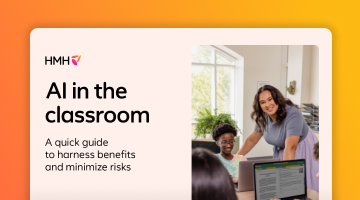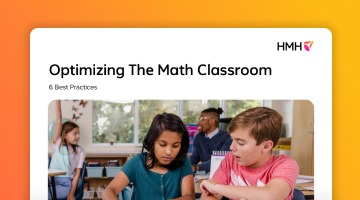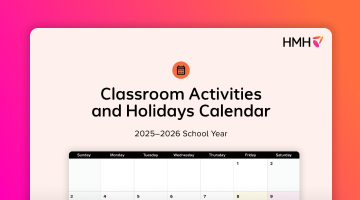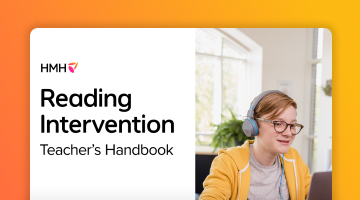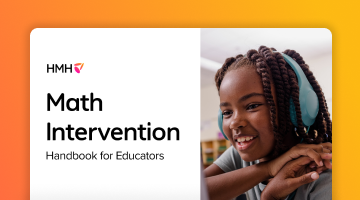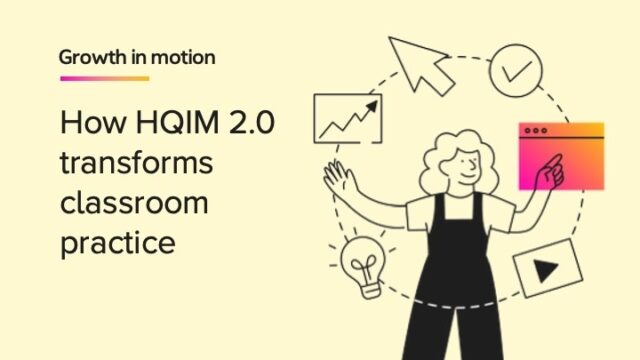
What are HQIM?
Imagine a classroom where students are working through a math problem that requires them to model a real-world situation, like determining how many solar panels a school would need to power its classrooms. In addition to solving the problem, they’ll need to justify their reasoning and critique each other’s approaches. The teacher uses a program like HMH’s Into Math to spark a rich discussion in problem solving. This is an example of instructional resources supporting rigorous thinking, a key component of high-quality instructional materials (HQIM).
So, what are HQIM?
HQIM are resources designed to support effective teaching and meaningful learning. They can be defined as standards aligned, evidence-based, and student-centered materials that include comprehensive teacher support and integrated assessments. HQIM are a strategic lever for improving student outcomes and supporting teachers across classrooms.
Why HQIM matter
Instructional materials shape what students learn and how they learn it. When materials are poor quality, even the best teachers struggle to deliver effective instruction. HQIM matter because they:
- Ensure consistency across classrooms and schools.
- Support teachers with professional learning.
- Improve student outcomes by aligning with state standards and research-based practices.
- Engage students through relevant and thought-provoking content.
In short, HQIM help create classrooms where students are challenged, supported, and inspired. With the right tools, it’s easier for teachers to succeed.
What makes instructional materials high-quality?
As an administrator, you may be tasked with evaluating curriculum options. There are a few attributes to look for when choosing your HQIM.
At a basic level, materials should be tightly aligned to your state’s academic standards, ensuring students are building grade-level skills in each subject area. Many states also have their own HQIM criteria aligned to state legislation and policy for instructional materials purchasing, such as instructional strategies needing to be backed by research.
Additionally, materials should reflect different experiences and perspectives. This helps students feel seen and builds a more collaborative learning environment. They should also be engaging. Look for materials that spark curiosity and encourage active learning through hands-on activities, real-world connections, and opportunities for collaboration.
Formative and summative assessments should be built into the materials, allowing teachers to monitor progress and adjust instruction in real time. HMH Classcraft provides standards-aligned, immersive learning experiences that support teachers in responding to students’ needs in real time. They can also help to inform next steps. To truly support teachers, HQIM should offer planning tools that guide instruction before the lesson begins and professional learning resources that help educators reflect and refine their practice.
With Into Math, that support is embedded, making math instruction feel more intuitive and allowing teachers to focus on student thinking and discourse. The Into Math teacher guide is built to support every phase of the teaching and learning cycle, helping all teachers—regardless of experience—feel confident in delivering rigorous content. These supports help ensure consistent access to high-quality math instruction across classrooms. Try this free resource, "Solve systems of linear equations by graphing," in the math classroom as an example. It provides a rich, real-world problem with formative checks like having students self-assess on prerequisite learning goals.

Tips for selecting HQIM
Choosing the right materials can feel overwhelming, especially with limited time and budget. Here are some practical tips to guide your selection process:
1. Establish process
Create a budget, timelines, and milestones, from setting up an adoption committee through implementation and ongoing professional learning on the materials.
2. Engage stakeholders
Include teachers, instructional coaches, and even families in the review process. Their insights can help you choose materials that meet real needs in the classroom and larger community.
3. Set priorities
Establish an instructional vision that can guide your selection of materials. Measure your instructional vision against data on student performance, teacher experience and readiness, etc. to help determine what you really need from instructional materials.
4. Read trusted reviews
Use resources like your state’s curriculum review site. Independent evaluations assess materials for usability, quality, and standards alignment.
5. Pilot before full adoption
Try out a lesson in a few classrooms. Gather feedback from teachers and students to understand how the materials perform in practice.
6. Check for scalability
Ensure the materials can be implemented across grade levels and schools with consistency and what professional learning your district would need to implement the curriculum well. Look for flexible formats and clear pacing guides.
Tips for implementing HQIM successfully
Once you’ve selected your materials, the real work begins. Implementation is where HQIM can thrive. It takes 3–4 years to achieve full implementation of HQIM in order to maximize the return on this investment your district is making. Here’s how to set your team up for success:
1. Invest in professional learning
Provide ongoing training for teachers and leaders to explore the materials, build content knowledge, collaborate with peers, and refine their practice. This professional learning includes teachers—including intervention and multilingual learner teachers—identifying the background knowledge students would need to access grade-level content. Then, how Tier 2 and Tier 3 supports can address gaps in student learning that must be addressed to meet the rigor of the instructional materials.
2. Create time for collaborative planning
Build in time for teachers to plan together using the new materials. Collaborative planning builds community and allows for shared problem-solving. For example, teachers should be reviewing the math content knowledge required for them to teach an upcoming unit together, drawing on real lessons, and planning for how they’d address common student misunderstandings.
3. Monitor and support
Use classroom observations, student data, and teacher feedback to monitor implementation. Offer coaching and support where needed.
4. Celebrate wins
Share stories of success—like the student who finally grasped a math concept or the teacher who found a new favorite science experiment. These moments build momentum and buy-in.
It’s about more than test scores
As a school or district leader, your decisions can shape the learning experiences of hundreds, if not thousands, of students. Choosing the right high-quality instructional materials is one of the most impactful choices you can make.
HQIM aren’t just about better test scores (though they help with that, too). They’re about creating classrooms where students feel supported and teachers feel confident. And where learning is joyful and effective.
***
Classcraft provides standards-aligned, immersive learning experiences that support teachers in responding to students’ needs in real time. The result: less teacher planning, more student engagement.
Get the guide "Beyond Intervention: How to Make Proficiency Stick for Every Learner."

